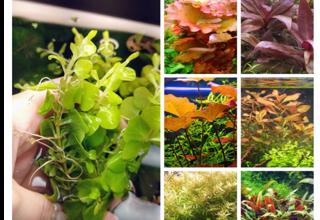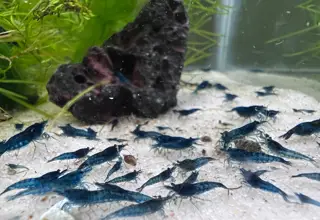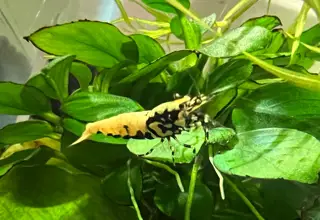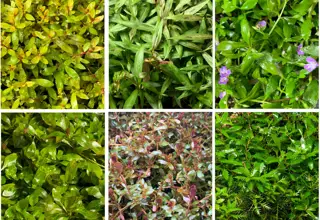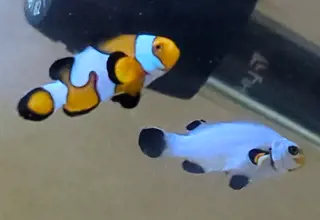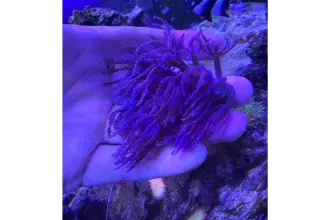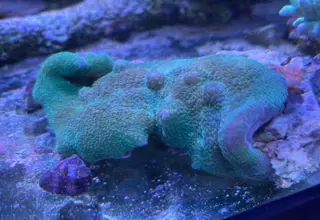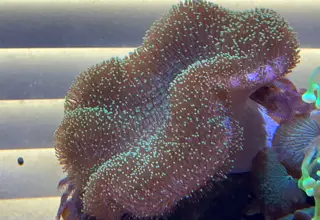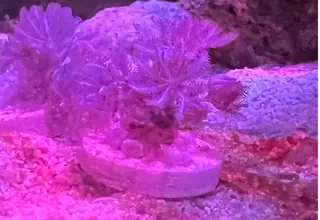Yellow Coris Wrasse: Care, Appearance, Reef Compatibility & More
Posted by on 2/08/2023
We use affiliate links and may receive a small commission on purchases.
Wrasses are some of the most peaceful fish in the saltwater aquarium hobby. These fish have a lot to offer, with over 600 documented species in the wild, they display some of the most striking color patterns found in marine fish.
While it's easy to understand why some hobbyists pursue some of the more colorful wrasses, some species are staples in the marine aquarium hobby. One of these wrasses, the Yellow Coris Wrasse, is one of these staples. This fish has a brightly colored yellow body and is an excellent choice for hobbyists of any skill level. Still, you'll want to be well-versed in the history and care of this species before adding this fish to any saltwater tank. In this post, we'll review everything you'll need to know before purchasing this species.
Species Summary
The Yellow Coris Wrasse (scientific name: Halichoeres chrysus) is an affordable wrasse fish, hailing from the reefs of the Solomon Islands, Southern Japan, and the Australian Coast. These wrasses live in small groups, where they feed on small crustaceans found along the ocean floor.
First scientifically classified by American Ichthyologist, John Randall , the Yellow Coris Wrasse comes from the Halichoeres genera, a large, sexually-dimorphic genus that comprises over 75 different species. Named after its yellow coloration, the Yellow Coris has achieved quite a few alternative names throughout the years. Canary Wrasse, Golden Wrasse, Golden Rainbowfish, and Yellow Wrasse are all used interchangeably to refer to Halichoeres chrysus.

Appearance
The Yellow Coris Wrasse has an all-yellow body, with semi-translucent dorsal, caudal, and pectoral fins.
Hobbyists looking to determine the gender or age of the fish should inspect their dorsal fins for dime-sized black dots. Mature males will display only a single dot along the dorsal fin, while females and juvenile fish will have 3 black dots.
When examined closely, males will showcase unique stripes that stretch horizontally from the mouth when they reach sexual maturity, at about 1 year of age.

Size
The Yellow Coris Wrasse is a relatively small fish, with adult males only growing to about 5 inches in length.
Juveniles and females will typically be quite a few inches small, and a pristine environment combined with a nutrient-rich diet will encourage a healthy adult size.
Yellow Coris Wrasse vs Banana Wrasse
Occasionally, hobbyists will refer to the Yellow Coris Wrasse as the Banana Wrasse, and it's easy to understand the confusion, both share similarities in appearance, but they are two separate species from two different genera.
The Banana Wrasse (scientific name: Thalassoma lutescens) will grow to more than double the size of a Yellow Coris, and as such requires a much larger aquarium. Banana Wrasses also feature a slightly different coloration, with shades of orange being much more prevalent along the body of the fish.

Yellow Coris Wrasse Care
One of the best parts about owning a Yellow Coris Wrasse is that they are relatively easy to care for. However, there are certain traits that wrasses possess that you'll want to be aware of.
Luckily, these fish are well documented, as they've been a staple in the saltwater aquarium hobby for decades. If you're considering purchasing a Yellow Coris Wrasse, it's important to recreate their native environment as closely as possible.
Lifespan
While wrasses are known for their short lifespans, hobbyists will be happy to know that the Yellow Wrasse is a unique exception, and when given a proper habitat and diet, these fish can live for up to 7-8 years in a saltwater aquarium.
The lifespan of these fish often depends on the genus, but providing a stress-free environment with pristine water conditions will give you the best shot at your yellow wrasse reaching its full life expectancy.
Tank Size
The Yellow Coris Wrasse should be kept in an aquarium that's at least 50 gallons in size.
If budget allows, an even larger aquarium is recommended. Larger tanks tend to be much more stable compared to nano aquariums and open the door to interesting coral and tank mate additions.
Acclimation
To Acclimate a Yellow Coris Wrasse, match your quarantine tank salinity to the salinity of the bag transporting your Yellow Coris.
Once you've matched the salinity, float the Yellow Coris Wrasse bag in the quarantine tank for about 20 minutes so that the temperature in the bag matches the temperature of the quarantine tank.
After 20 minutes, you can release your Yellow Coris Wrasse into your quarantine tank, where it should be kept for at least 20 days. Observe your fish for any potential parasites or diseases. Assuming all looks good, you can transfer your Wrasse into your display tank's acclimation box where it should remain for an additional 2-3 days. After the 2-3 day period, you can remove the fish from the acclimation box and release it into your display tank.
We strongly recommend having an established quarantine tank before purchasing a Yellow Coris Wrasse. Quarantine tanks can help prevent diseases such as marine velvet and ich from decimating a display tank, a scenario no hobbyist ever wants to face.
Water Conditions
In their native habitat, the Yellow Coris Wrasse lives in warm, shallow waters, with high levels of sunlight and dissolved oxygen. In an at-home aquarium, you'll want to recreate these conditions as closely as possible.
Aim for the following water parameters:
Temperature Range: 72°F-78°F
Specific Gravity: 1.020-1.025
KH: 8-12 dKH
pH: 8.1-8.4
Nitrites, Nitrates, and Ammonia should be kept at 0 ppm. Always introduce fish to an already established aquarium, and maintain these water conditions for as long as you plan on keeping your saltwater aquarium running. Keep in mind that stability is one of the most important elements in marine fishkeeping.
Tank Setup
Yellow Coris Wrasses should only be introduced to a well-filtered, established aquarium.
All Wrasses are known jumpers, making a tight-fitting lid a must when caring for these species. You'll also want to have a fine-grain sandbed, such as live sand from Gulf Live Rock . Species that fall under the Halichoeres genera are sand-sleepers, including the Yellow Coris, meaning they'll bury themselves in the sand at night.
Aim for at least an inch of sand, and avoid abrasive substrates, such as crushed coral, as it can irritate and scrape the fish resulting in potential infection.
In terms of flow, Yellow Coris are adaptable but prefer areas of high flow.
As far as lighting goes, T5 lighting is an excellent and inexpensive choice. Many hobbyists will use white lighting to show off the best coloration with these fish.
Plenty of live rock should be added so that these fish can seek refuge when stressed. Be sure not to overcrowd the tank, as these fish will also appreciate open spaces to swim throughout.

Common Diseases
Wrasses, including the Yellow Coris, are susceptible to many of the same diseases that affect marine fish. However, due to their slime coat, they are more resistant to Protozoans. These small single-celled organisms are responsible for causing diseases such as Brooklynella, a common disease seen in clownfish.
Marine Velvet and Ich are diseases that hobbyists should be aware of when purchasing a Yellow Coris Wrasse. Placing your fish in a quarantine tank before introducing it into your display tank can prevent a fatal outbreak, but we always recommend reading up on the differences and treatment options for these diseases.
Food & Diet
The Yellow Coris Wrasse is a carnivorous fish and should be fed a meaty diet, consisting of Mysis shrimp and Brine shrimp at least 3-4 times per day.
Keeping your Yellow Coris fed will prevent them from picking at any invertebrates you may have in your aquarium, and will also bolster their immune system, giving them a stronger chance at fending off potential diseases.
Although optional, you can supplement your wrasse's diet with Nori.
Hobbyists may also enjoy knowing that the Yellow Coris Wrasse is one of the best pest-eating fish in the hobby. As active hunters, they will consume flatworms, bristle worms, and nudibranchs.
Reef Compatibility
Yellow Coris Wrasse are reef-safe fish and can play an important role in a reef aquarium due to their pest-consuming abilities.
However, reefers should proceed with caution if their reef tank contains invertebrates such as Pistol Shrimp. The Yellow Coris Wrasse is a carnivorous fish and may pick at any invertebrates that roam the tank. You can prevent this behavior by keeping your Yellow Coris well-fed. Feeding them 3-4 times a day works well in most cases.
Behavior and Temperament
The Yellow Coris Wrasse is a peaceful fish and can co-exist with many other species of marine fish. When awake, they're active swimmers and can be found near the bottom and middle section of the water column.
When sleeping or scared, the Yellow Coris may bury itself in the sandbed. Recently acclimated fish may stay buried for a day or two, and in rare cases may bury for up to a week.
Tank Mates
Due to their peaceful temperament, Wrasses can do well with a variety of different marine fish. Provided you have a tank large enough to house additional fish, some of our favorite tank mates include the following.
If you plan on keeping your Yellow Coris well fed, Fire Shrimp and Cleaner Shrimp may be added. If you're considering adding the Yellow Coris to a reef tank, they are reef-compatible, and do well with a variety of corals, including blastos, leather corals, chalices, candy canes, brain corals, and torches.
You can pair your Yellow Coris with other wrasse species, just be sure to slowly introduce any new wrasse by using an acclimation box. Avoid adding additional Yellow Coris Wrasses, since these fish can transition between genders, it's easy for multiple fish of the same species to encounter territorial disputes.
You'll also want to avoid adding aggressive fish, such as the Tessalata Eel and Maroon Clownfish
Breeding
Unfortunately, all Yellow Coris Wrasse are imported but are abundant in the wild, where they have a "Least Concern" conservation status .
While some Wrasse species have been successfully bred in captivity, the process is quite difficult. If you're interested in learning more about breeding wrasse, Elizabeth Groover, an expert in ornamental aquaculture, gives a great review of the topic.
Where To Purchase
The Yellow Coris Wrasse can be purchased at a local fish store or through an online vendor, such as those that sell on our marketplace.
Customers looking to place an online order should be aware that wrasses are sensitive to shipping conditions. Packaging and shipment methods should only be trusted with the most experienced vendors.
In Conclusion
As you can see, the Yellow Coris Wrasse is an amazing species that is popular in the marine aquarium hobby for a reason. Its peaceful temperament, reef compatibility, and striking coloration make it a favorite amongst hobbyists.
Now that you've learned the ins and outs of this species, do you plan on adding one to your saltwater tank? Let us know by commenting below, and be sure to check out our community forum and marketplace, where you can meet and trade with other hobbyists.
